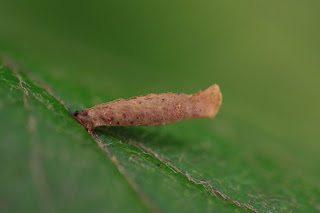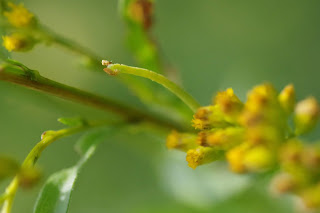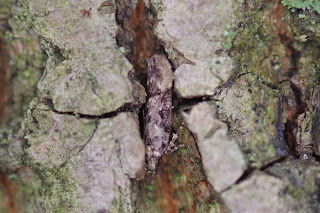Backyard Bug of the Day:
Cicada. We have annual cicadas here in my backyard, not the 17 year ones, or the 8 year ones, or whatever other intervals they have. Either way, cicadas spend most of their life cycle underground. They hatch from eggs laid in trees and drop to the ground, where they burrow in and feed off of tree roots for most of their lives. When they are ready to become adults they come out of the ground, crawl up a tree and molt out of their exoskeletons, emerging as adults (with new exoskeletons, and wings). They then spend their brief (a couple of weeks, I think) adulthood up in trees, making a lot of noise in an attempt to find a mate. After they mate and eggs are laid... that's it. The cycle starts anew with the next generation. I never seen them as larvae/nymphs. I rarely see them as adults, though I hear them loud and clear. Occasionally–and I mean maybe 5 times in the last 19 years–I see one on a tree trunk low enough that I can get a look at it, or see one flying (which they do loudly and clumsily). This particular one flew down from higher up just as I was walking by, and that is why I was able to see it. And from the picture you can probably tell that it landed above my head. I got three shots before it flew away again–higher up into the trees.
Other Bugs:
Assassin bug with bee prey
Chrysalis of some kind
Lady beetle. This this is tiny. A couple of millimeters long, maybe.
I'm not expecting this caterpillar to be around much longer in its caterpillar state. Soon this will be working on becoming a butterfly.
There seems to be a constant stream of sawfly larvae somewhere or other in the backyard all summer:
Before I touched the leaf...
Defensive postures after I touched the leaf
Brown hooded owlet moth caterpillar that has just molted. Behind (above) it you can see the skin it just shed...
... and below it is its former, smaller face.
That one goldenrod plant still has looper caterpillars on it, but not as many. I only found two today. There is something very funny about caterpillars standing straight up. It's not how I thought caterpillars behaved (before I started actually paying attention to what insects do).
Ailanthus webworm moth (nobody tell the arachnophobes about the spider lurking in this picture)...
... and a sweat bee. Goldenrod appeals to all kinds of insects.
Tiny moth hiding in tree bark.
I should go back and count how many species of caterpillar I have seen in my backyard this week... 18. And that's just since Wednesday.
Guess what this monarch butterfly is doing, other than not posing nicely for a picture?
I am finding a lot of little crickets on the milkweed plants this week.
The ragged ambush bugs don't have any prey today. Just each other.
White marked tussock moth caterpillar
There is a species of moth that lays eggs on the deer netting around the blueberry bush every year.
The white thing is a ragged ambush bug nymph. The blue thing is a beetle that it surprisingly did not prey on, even though the beetle walked right over the ambush bug's head several times.
If this fly had been more cooperative I would dignify it by looking up its name, but I am not going to.
.
.
.
.
.
.
.
.
.
.
.
.
Female above, male below. The female is bigger, the male has bigger chelicerae (where the fangs are).
Spined micrathena
Dorsal view
I think this is a jumping spider that has died from a fungus of some kind. Nature as creepy sci-fi.

































No comments:
Post a Comment